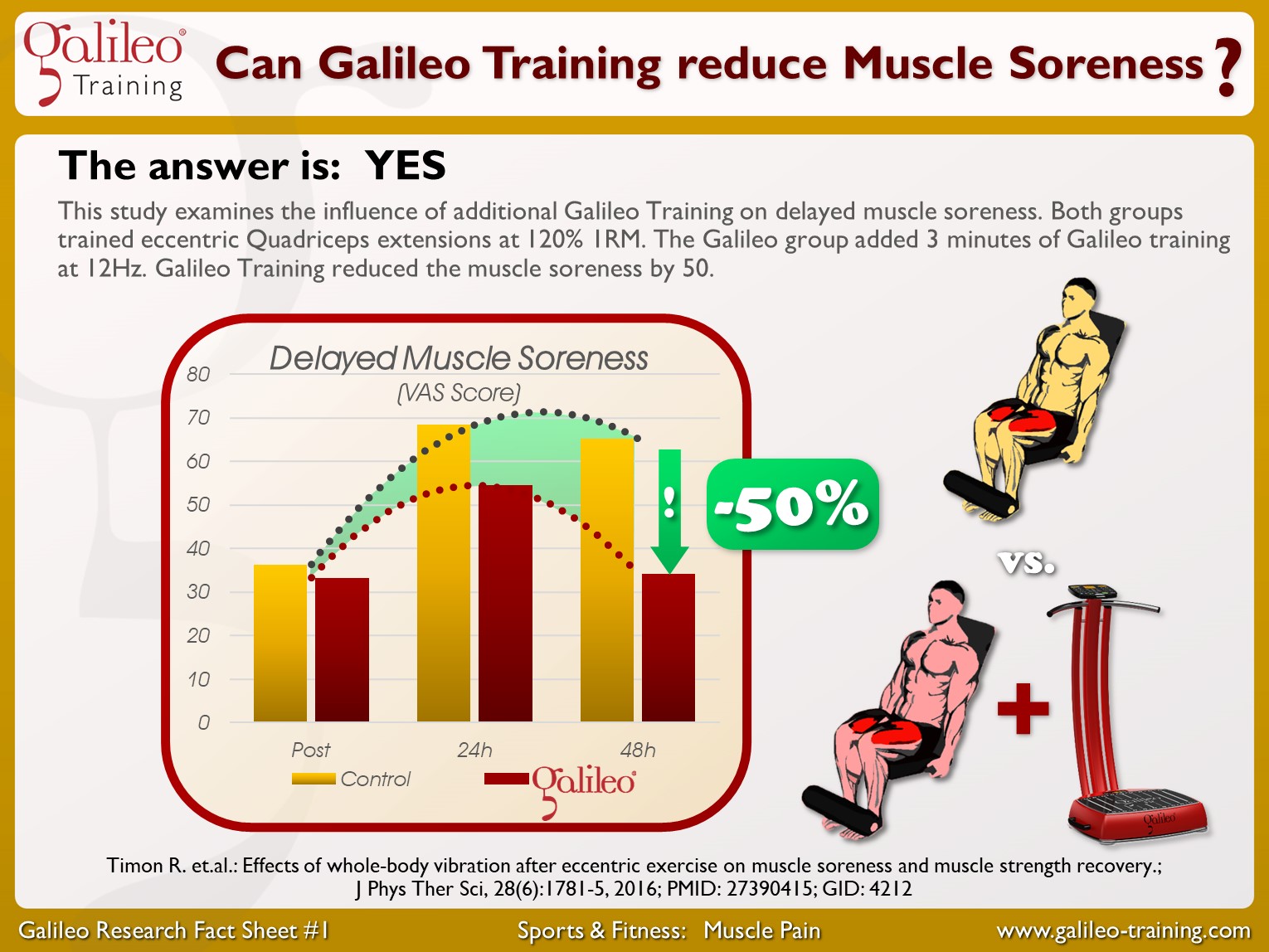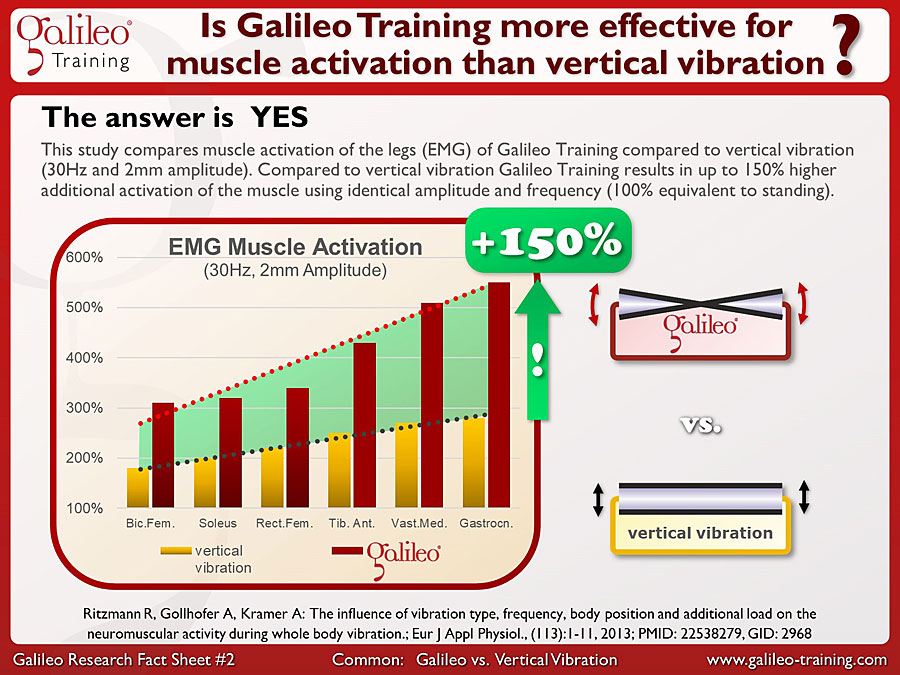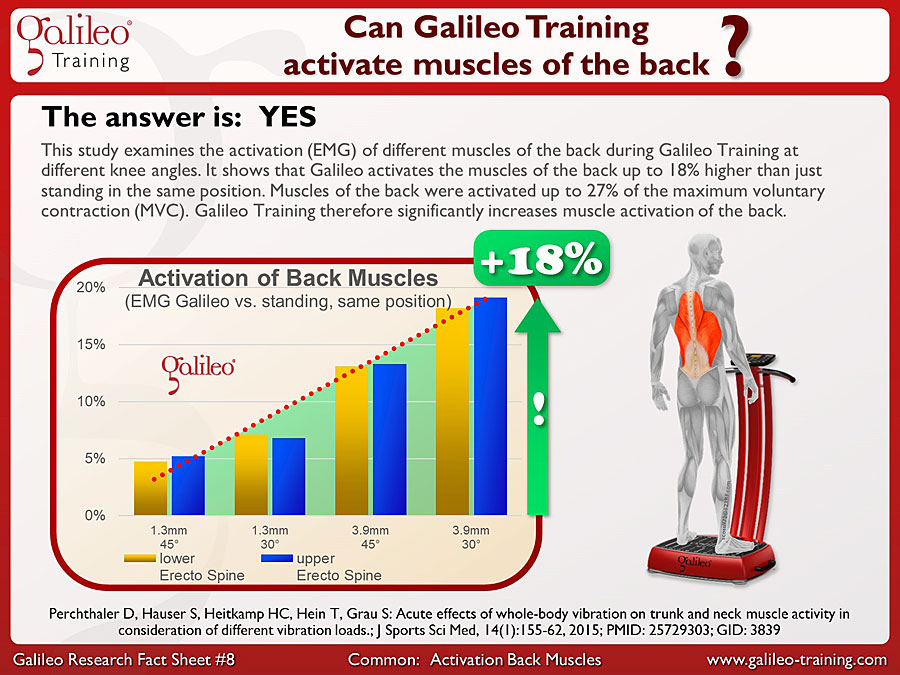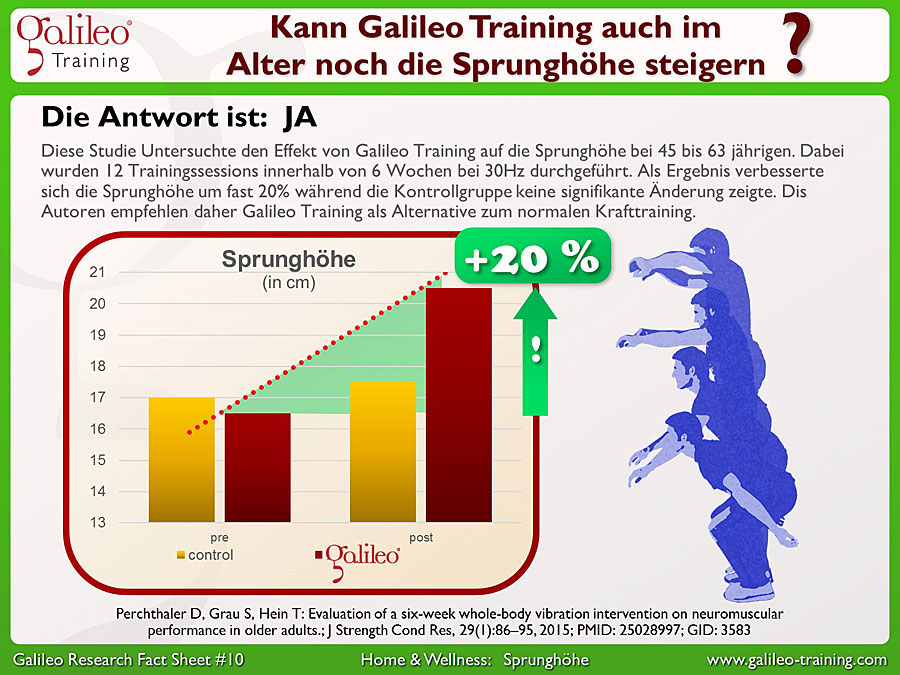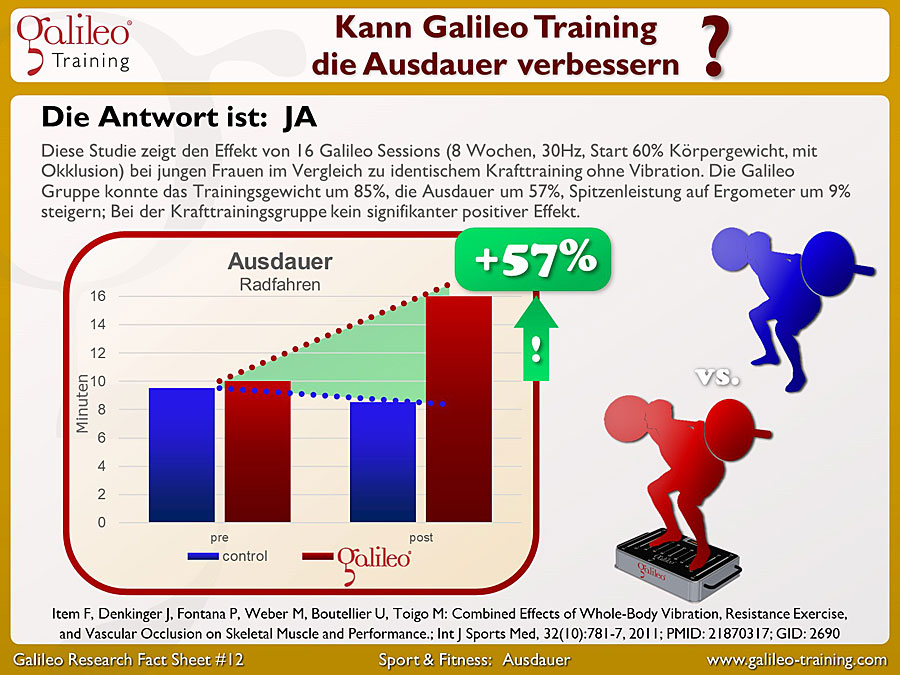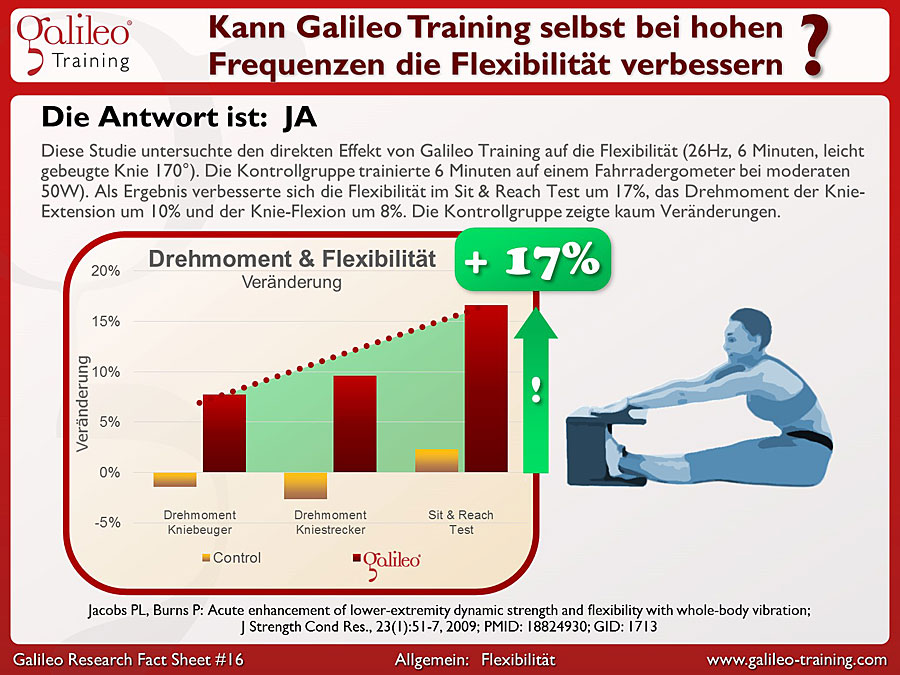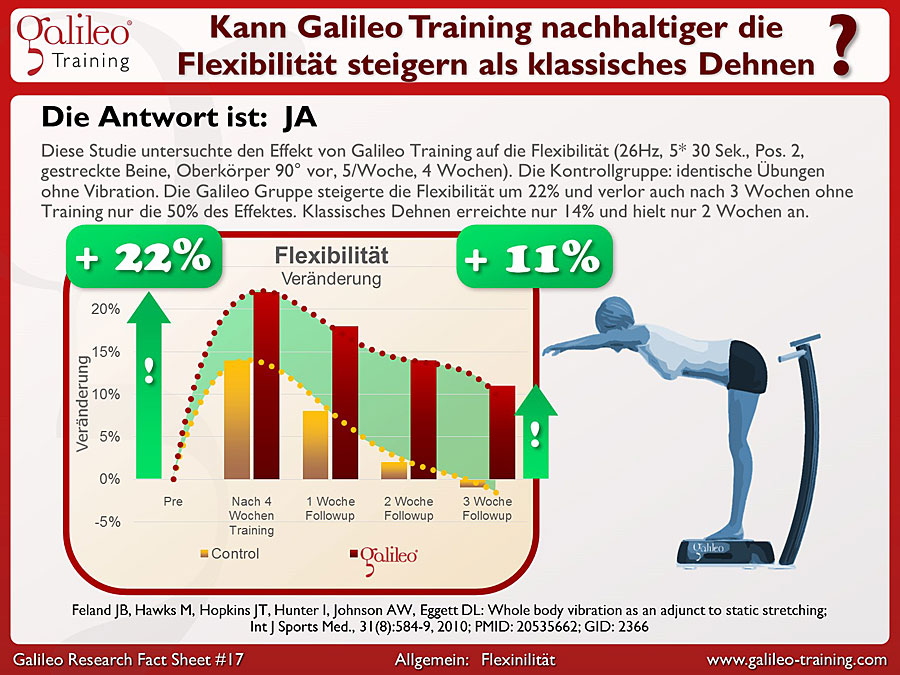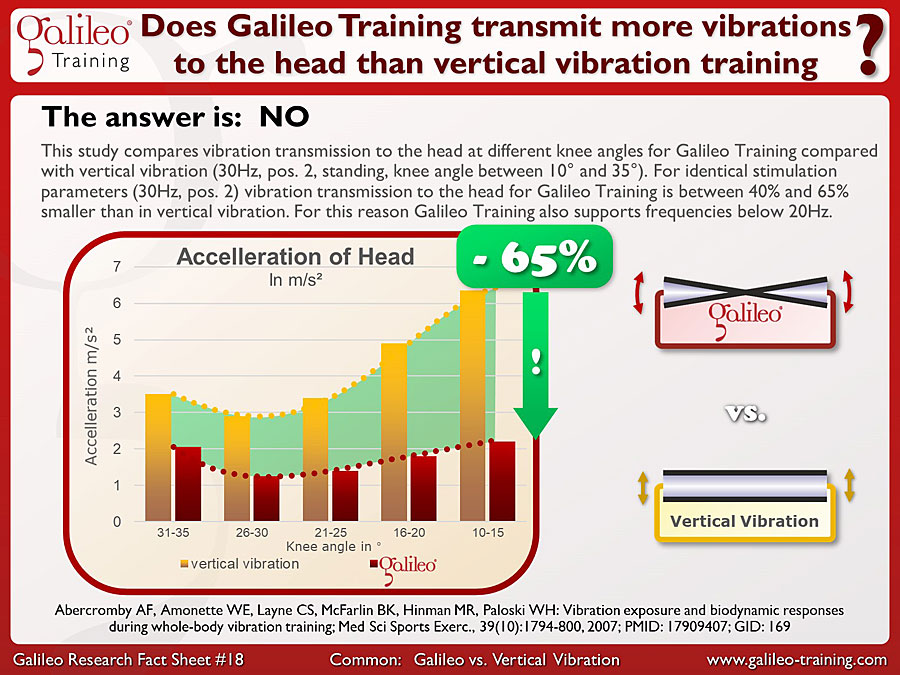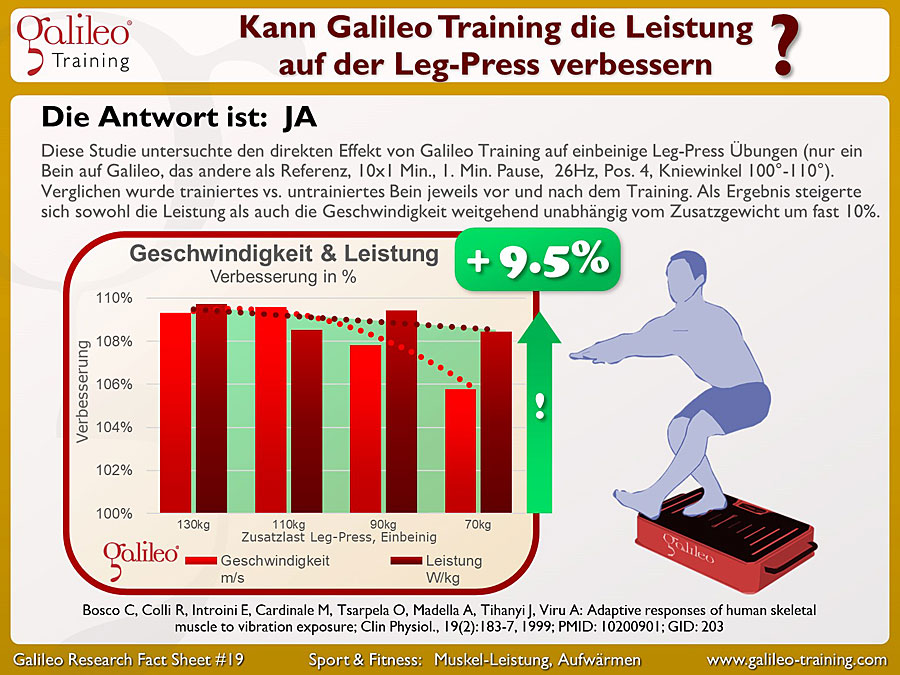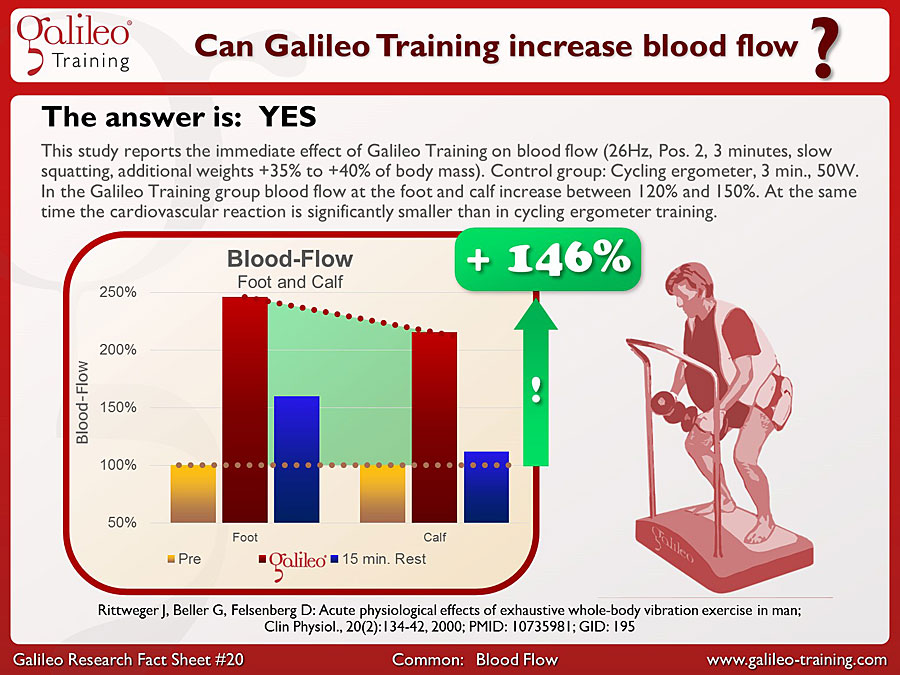Scientific background
A large proportion of the scientifically recognised studies published in reviewed journals (currently well over 500) on the topics of “vibration therapy” and “vibration training” were actually carried out with Galileo equipment.
Read below to find out how Galileo vibration training devices differ fundamentally from other vibration devices.
In addition, a distinction must be made between training equipment and equipment with medical device approval. The majority of the vibration devices available are purely training devices.
Galileo, on the other hand, offers an exercise equipment series as well as a therapy equipment series.

Differences to non side-alternating units
1. type of vibration

Side-alternating vibrationSide-alternating vibration
Side alternation = rocking movement:
left and right sides of the plate move up and down in opposite directions. Simulates the human gait.
Physiological movements such as walking or running are simulated by the plate movement of Galileo training devices.
While walking, the same muscles of the right and left side of the body are never used at the same time in the same way – but always alternately!
Non-side-alternating vibration
Dominant vertical movement: left and right sides move up or down simultaneously.
The non side-alternating up and down movement of many other vibration training devices does not correspond to the typical human form of locomotion (e.g. walking or running), as humans generally do not move in a hopping manner (like a frog or a kangaroo, for example).
Such systems are also referred as lineal, synchronous or vertical vibration devices.
2. Influence on the back muscles

Side-alternating vibrationSide-alternating vibration
The side-alternating movement of Galileo standing devices leads to an alternating transmission of force to the legs, which is transferred to the pelvis. This lateral tilting of the pelvis leads to a alternating activation of the back muscles (analogous to physiological movement sequences such as walking and running).
Non-side-alternating vibration
By lifting both legs at the same time, the pelvis is not tilted but only moved vertically. The lack of side-alternating relative movement between pelvis and back diminishes the training effect.
3. Wide frequency range enables a wide variety of training goals

Side-alternating vibrationSide-alternating vibration
Galileo offers an adjustable frequency between e.g. 5 and 40 Hertz*.
The frequency range used determines the training target:
Typical frequency ranges for Galileo are:
-
- approx. 5-10 Hz – mobilisation
Voluntary balancing of the rocking movement dominant. Relaxation of muscles, improvement of proprioception and balance. - approx. 12-20 Hz – muscle function
From approx. 12 Hz triggering of the stretch reflex dominant. Improvement of muscle function and coordination, muscle relaxation and release, stretching of the muscle and tendon system, flexibility, promotion of blood circulation. - approx. 25-40 Hz – muscle power
Increasing tone, increasing muscle power and endurance capacity, increasing or maintaining muscle strength, muscle building, body shaping.
- approx. 5-10 Hz – mobilisation
*) the frequency range varies between 12 to 27 or 5 to 40 Hz depending on the model.
Non-side-alternating vibration
Usually adjustable from approx. 20 Hz to 60 Hz (mostly between 25 and 40 Hz).
Therefore, the use of frequencies below 20 Hz with the associated therapy goals is generally not possible (only a few vertically vibrating devices support frequencies below 20 Hz).
- approx. 20-50 Hz – muscle power
Increasing tone, increasing muscle power and endurance capacity, increasing or restoring muscle strength, spasticity management.
4. Easily adjustable amplitude (intensity)

Side-alternating vibrationSide-alternating vibration
The amplitude (deflection of the plate) essentially determines the intensity of the application. With Galileo upright units, the amplitude can be freely selected simply by foot position between approx. 0 and up to 6 mm (corresponds to a stroke of approx. 0 to 12 mm)*.
*) the maximum possible amplitude varies between 2.5 and 6 mm depending on the model.
Non-side-alternating vibration
The vast majority of all devices offer little or even only one preset amplitude, usually 1 mm to 2 mm (corresponding to a stroke of 2 mm to 4 mm).
5.Reproducibility of the force transmission

Side-alternating vibrationSide-alternating vibration
Highly reproducible movement of the vibration platform due to the mechanically guided movement (imprinted displacement).
The design of Galileo training equipment ensures a sinusoidal (harmonic) movement of the vibration platform, independent of the user’s body weight and stiffness.
This allows an objective assessment and comparability of parameters and thus of training successes, which is a decisive advantage for the use of Galileo devices in scientific studies, for example.
Non-side-alternating vibration
Usually no mechanically fixed guided movement
(thus no imposed displacement). Spring-mass systems are usually used as drives. However, these are principally dependent on the mass and stiffness of the person exercising.
6. Vibration transmission to the head

Side-alternating vibrationSide-alternating vibration
Due to the side alternation principle, there is very little vibration at the head: The rocking movement of Galileo standing devices leads to an alternating force transmission into the legs, which is transferred to the pelvis. This lateral tilting of the pelvis leads to a reciprocal activation of the back muscles, analogous to physiological movement sequences such as walking and running. The spine thus ends up in the axis of rotation of the lateral pelvic movement, which significantly restricts the vertical movement of the spine and of the head.
Non-side-alternating vibration
The head vibrates significantly more:
By lifting both legs at the same time, the pelvis is not tilted but accelerated vertically to varying degrees depending on the leg stiffness. Due to the lack of compensatory movement of the pelvis, the spine and thus the head are moved significantly more than with the side-alternating movement.
More detailed background information can also be found in: Rittweger, Rawer et. Al: Manual of Vibration Exercise and Vibration Therapy, Chapter 3: Design Principles of Available Machines, Springer 2020; ISBN: 978-3-030-43985-9
Differences to low intensity vibration (LIV)
Micro-Vibration
Low intensity vibration devices (LIV) are also vertical vibrating devices, but using very small amplitudes in the range of 0.1 mm, typically in the frequency range of 20 to 60 Hz.
In addition to the aforementioned differences to vertically oscillating units, the following aspects must also be taken into account.
Safety aspects
The main argument in favour of micro-vibration is the claim that larger amplitudes would violate occupational safety regulations and would therefore be dangerous, especially in the case of osteoporosis.
However, this is not correct for the following reasons:
- The amplitude used can be continuously adjusted on Galileo devices based on the selected foot position. With the typically used amplitudes of approx. 2 mm at higher frequencies (30 Hz), regular use of up to 30 minutes per day is therefore harmless according to occupational safety standards.
- Typical negative side effects considered in the field of occupational safety are circulatory disorders. However, the literature on Galileo application shows increased and not reduced blood flow.
- More than 25 years of experience in the use of Galileo in osteoporosis patients, but also the use in brittle bone patients (osteogenesis imperfecta) with consistently positive results disprove the claim.
Occupational safety standards are based on non-physiological impact-type applications (e.g. jackhammer). They are therefore not correctly applicable to training and therapy based on physiological forms of movement (i.e. movement sequences known to the body and used on a daily basis). For example 2 minutes alpine down-hill skiing already exceeds the daily limits according to work safety regulations.
Study results
The body of evidence of whole body vibration using higher amplitudes covers currently in the order of 1700 publications, over 600 of which are using Galileo devices. Compared to this number, the topic of micro-vibration with a number of publications in humans in the mid 2-digit range could rather seen seen as a niche topic of international research.
Duration of application
The typical duration of use for micro-vibration, as used in studies, is between 20 and 30 minutes daily with upright (passive) standing.
In comparison, the typical use for osteoporosis in studies conducted with Galileo is 9 minutes 2 to 3 times per week.
Application goals
The typical therapeutic target for the use of micro-vibration, which has also been scientifically studied, is primarily the bone itself. However, this falls short of the risks for osteoporosis patients, because it simply ignores the crucial point of fall prevention.
However, fall prevention is a neuro-muscular issue (balance, proprioception, flexibility, functional and powerful "strong" muscles). These are all aspects on which the effectiveness of Galileo Therapy has been proven in many studies. Galileo therapy thus follows a holistic approach and does not focus on the bone alone, as many pharmaceuticals do.

Do you have questions about our products or would you like to purchase a product?
Get advice from our experts. Simply arrange a phone-call to answer your questions.
Differences to low-cost side-alternating units
Sophisticated design allows wide range of performance and applications
A complex mechanism requires more individual parts and is therefore more expensive to manufacture. However, this allows a smooth operation over a very wide frequency spectrum without the need for aids such as suction cups on the feet or a very high unit mass.
A statement such as: "A good vibration training device must weigh at least 50 kg" therefore applies at best to devices where drastic savings have been made on the mechanics at the expense of the function.
A sophisticated complex construction, however, as in the case of Galileo, also enables a very high level of durability and sustainability, because it can also be repaired if necessary.
Range of applications
The used frequency range typically covers 5 Hz 50 14 Hz (even if the display shows a "speed" between 1 and 50).
Therefore, the use of frequencies above 15 Hz with the associated therapy goals is generally not possible.
In particular, coordinative exercises at 15-20 Hz, but also exercises to build up muscles and to increase the function/power of the muscles are only possible to a limited extent in this way.
Reproducibility
The complex mechanics, especially the double-sided drive, enables a highly reproducible application largely independent of body mass and muscle function. It also guarantees a constant stimulus during intensive training.
Safety aspects
The field of occupational safety addresses impact-like, non-physiological forces, such as those generated when operating a jackhammer.
Low-cost units with much simpler mechanics (e.g. with a single-sided drive), however, generate shock-like components due to their design. This is particularly noticeable during intensive use, for example because the tread surface twists or the feet of the device are briefly relieved during the workout despite suction cups and the device hits the hard floor again during the subsequent downward movement.
Galileo units, on the other hand, are designed due to their complex mechanics: to generate sinusoidal (harmonic) movements and thus avoid shock-like components (high-frequency components). In addition, if the operator uses the device incorrectly, the Galileo Smart Coaching function ensures that the operator is warned or even the intensity is automatically reduced*.
*) Depending on the Galileo device model, the range of functions varies.
Study results
There are currently well over 500 scientific publications on the application of Galileo devices alone. They cover an extremely wide range of applications. All publications to which we refer were also carried out with Galileo devices.
The majority of vibration devices on the market, on the other hand, use studies that were carried out with other devices, often with other frequencies, other amplitudes or even other principles of action. However, there is usually no proof that these study results can be transferred to the company's own product.
Good evidence based research on the advertised device is therefore essential to ensure that the results of studies can be achieved.
Quality: durability and sustainability
A well engineered design of the device mechanics is crucial to enable a long-lasting but also a well repairable system - both essential aspects of sustainability. The elaborate design of the Galileo units therefore not only enables smooth operation, but also minimises internal wear.
For Galileo devices, 10 or 15 years of use even in professional daily use is the norm and not the exception. As standard, we guarantee availability of spare parts for at least 10 years after purchase. If requested, we can also repair all Galileo device variants ever produced in the last 25 years.
Made in Germany
In order to meet our very high quality standards, Galileo devices are developed and produced exclusively in Germany.
Systems below the €3000 mark, in contrast, are almost exclusively produced in Asia, especially in China.
Galileo® Space
VIBRATION TRAINING IN SPACE RESEARCH
Galileo® is the vibration training device frequently used in space research.

You would like to know more about the background of Galileo® Training ?
Choose one of the following topics:
Galileo® active principle side alternation
Frequency ranges and their effect
Galileo® Basic Exercises
Galileo® Training Fact sheets
Research results on the application of
Galileo® Training. Get fit - stay fit.
